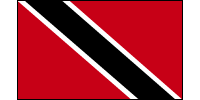| Maps | Caribbean | Trinidad and Tobago | Island of Trinidad | ||||||||||||
| Country | Republic of Trinidad and Tobago | ||||||||||||
| Capital | Port-of-Spain | ||||||||||||
| Total Area | 1,979.93 sq
mi 5,128.00 sq km (slightly smaller than Delaware) |
||||||||||||
| Population | 1,175,523 (July 2000 est.) | ||||||||||||
| Languages | English (official), Hindi, French, Spanish, Chinese | ||||||||||||
| Literacy | 97.9% total, 98.8% male, 97% female (1995 est.) | ||||||||||||
| Religions | Roman Catholic 29.4%, Hindu 23.8%, Anglican 10.9%, Muslim 5.8%, Presbyterian 3.4%, other 26.7% | ||||||||||||
| Life Expectancy | 65.45 male, 70.59 female (2000 est.) | ||||||||||||
| Government Type | parliamentary democracy | ||||||||||||
| Currency | 1 Trinidad
and Tobago dollar (TT$) = 100 cents
View the TT dollars |
||||||||||||
| Exchange Rate | A floating rate system is in force. Currently $1US=$6.24TT; $1CDN = $4.48TT | ||||||||||||
| GDP (per capita) | $8,500 (1999 est.) | ||||||||||||
| Time Zone | Summer: EST (Eastern Standard Time), equivalent to GMT (Greenwich Mean Time)-5 hours; Winter: EST+1, GMT-4. Daylight savings time is not observed in Trinidad and Tobago. | ||||||||||||
| Ethnic Profile |
|
||||||||||||
| Labor Force (by occupation) | construction and utilities 12.4%, manufacturing, mining, and quarrying 14%, agriculture 9.5%, services 64.1% (1997 est.) | ||||||||||||
| Industry | petroleum, chemicals, tourism, food processing, cement, beverage, cotton textiles | ||||||||||||
| Agriculture | cocoa, sugarcane, rice, citrus, coffee, vegetables; poultry | ||||||||||||
| Arable Land | 15% | ||||||||||||
| Exports | petroleum and petroleum products, chemicals, steel products, fertilizer, sugar, cocoa, coffee, citrus, flowers | ||||||||||||
| Imports | machinery, transportation equipment, manufactured goods, food, live animals | ||||||||||||
| Natural Resources | petroleum, natural gas, asphalt | ||||||||||||
| Current Environmental Issues | water pollution from agricultural chemicals, industrial wastes, and raw sewage; oil pollution of beaches; deforestation; soil erosion | ||||||||||||
| Airports |
|

National Flag